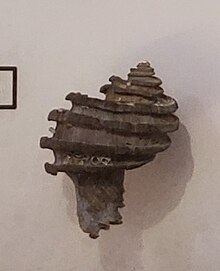
Ecphora gardnerae is a species of extinct predatory ocenebrinid murex gastropod. Shells of E. gardnerae are found in Miocene-aged marine strata of Maryland and Virginia.
The Langhian is, in the ICS geologic timescale, an age or stage in the middle Miocene Epoch/Series. It spans the time between 15.97 ± 0.05 Ma and 13.65 ± 0.05 Ma during the Middle Miocene.
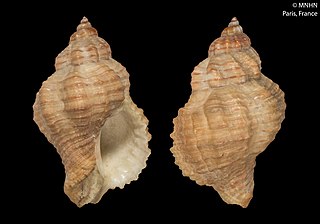
Urosalpinx is a genus of sea snails, marine gastropods in the subfamily Ocenebrinae of the murex snail family, Muricidae.

Hesperotestudo is an extinct genus of tortoise native to North and Central America from the Early Miocene to the Late Pleistocene. Species of Hesperotestudo varied widely in size, with a large undescribed specimen from the Late Pleistocene of El Salvador reaching 150 cm (4.9 ft) in carapace length, larger than that of extant giant tortoises. Historically considered a subgenus of Geochelone, it is now considered to be distantly related to that genus. Its relationships with other tortoises are uncertain. The exposed areas of the bodies of Hesperotestudo species were extensively covered with large dermal ossicles, which in life were covered in keratin. It has been suggested that species of Hesperotestudo were relatively tolerant of cold weather. Hesperotestudo became extinct at the end of the Pleistocene roughly co-incident with the arrival of the first humans in North America. There is apparently a site in Florida where one individual may have been killed that some suggested were evidence of butchering, although others suggested that the turtle was neither cooked nor does a ledge that was found near it date at the same time as it.

The Yorktown Formation is a mapped bedrock unit in the Coastal Plain of Maryland, Virginia, North Carolina and South Carolina. It is overconsolidated and highly fossiliferous.

Cymatosyrinx is a genus of sea snails, marine gastropod mollusks in the family Drilliidae.
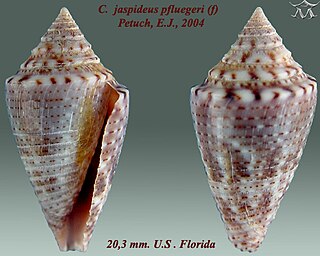
Jaspidiconus is a subgenus of sea snails, marine gastropod mollusks in the genus Conasprella, family Conidae, the cone snails and their allies.
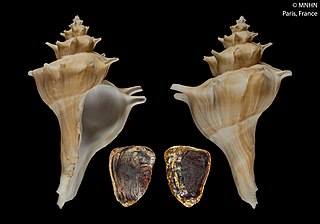
Forreria is a genus of marine gastropod mollusks in the family Muricidae, the murex snails or rock snails.

Ecphora is the common name for a group of extinct predatory marine gastropod mollusks within the family Muricidae, the rocks snails or murexes. The common name is based on the first officially described genus, Ecphora. The entire lineage of these ocenebrinid murexes are descended from the Eocene murex, Tritonopsis. Ecphoras were indigenous to the North American Eastern Seaboard, being found in marine strata from the Late Eocene until their extinction during the Pliocene. Many ecphora species are important index fossils.

Conasprelloides is a subgenus of sea snails, marine gastropod mollusks in the family Conidae, the cone snails and their allies.

Julia Anna Gardner, was an American geologist who worked for the United States Geological Survey for 32 years, was known worldwide for her work in stratigraphy and mollusc paleontology.
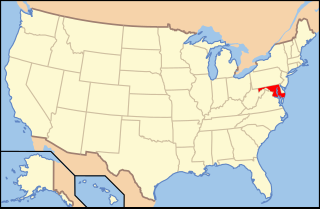
Paleontology in Maryland refers to paleontological research occurring within or conducted by people from the U.S. state of Maryland. The invertebrate fossils of Maryland are similar to those of neighboring Delaware. For most of the early Paleozoic era, Maryland was covered by a shallow sea, although it was above sea level for portions of the Ordovician and Devonian. The ancient marine life of Maryland included brachiopods and bryozoans while horsetails and scale trees grew on land. By the end of the era, the sea had left the state completely. In the early Mesozoic, Pangaea was splitting up. The same geologic forces that divided the supercontinent formed massive lakes. Dinosaur footprints were preserved along their shores. During the Cretaceous, the state was home to dinosaurs. During the early part of the Cenozoic era, the state was alternatingly submerged by sea water or exposed. During the Ice Age, mastodons lived in the state.
Trisecphora is a genus of extinct predatory ocenebrinid murexes indigenous to the Miocene coastline of what is now Maryland, North Carolina, and Virginia from the Aquitanian epoch until their extinction near the end of the Serravallian epoch. The common name for this genus and their relatives is "ecphora"(s).

The Chesapeake Group is a geologic group in Maryland, Virginia, Delaware, and North Carolina. It preserves mainly marine fossils dating back to the Miocene and Pliocene epochs of the Neogene period. This group contains one of the best studied fossil record of Neogene oceans in the world. Professional Paleontologists and amateur fossil hunters alike collect from this group intensely. The Calvert Cliffs stretch the length of Calvert County, Maryland and provide the best continuous stretch of the Calvert, Choptank, and St. Marys Formations. Ward (1985) recommended including the Old Church Formation in this group.
The St. Marys Formation is a geologic formation in Maryland and Virginia, United States. It preserves fossils dating back to the Miocene Epoch of the Neogene period. It is the youngest Miocene formation present in the Calvert Cliffs and is part of the Chesapeake Group.

The Choptank Formation is a geologic formation in Virginia and Maryland. It preserves fossils dating from the Miocene epoch of the Neogene period.
Inodrillia whitfieldi is an extinct species of sea snail, a marine gastropod mollusk in the family Horaiclavidae.

Lophocetus is an extinct genus of dolphin belonging to the clade Delphinida that is known from late Miocene (Tortonian) marine deposits in California and Maryland. Although usually placed in Kentriodontidae, recent studies have found it only distantly related to Kentriodon.

The Calvert Formation is a geologic formation in Maryland, Virginia, and Delaware. It preserves fossils dating back to the early to middle Miocene epoch of the Neogene period. It is one of the three formations which make up the Calvert Cliffs, all of which are part of the Chesapeake Group.
Gavia egeriana is an extinct species of loon from the Miocene epoch, where the holotype was found in Dolnice, Czech Republic dating to the Burdigalian. The holotype consisted of two distal ends of the humeri bones. Other more completed material has been found in the Calvert Formation from the Chesapeake Group in the United States, with possible material from the Pungo River Formation from North Carolina. These material consist of the right coracoid and nearly two-thirds of a right ulna and date to the Langhian. G. egeriana was a very small species of loon and it was the earliest, possibly the ancestral species that gave raise to the other species in the genus.

